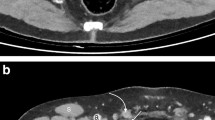Abstract
Aim
Groin ultrasound scan (USS) is used to aid the diagnosis of inguinal hernias. Our radiology department offers access to image symptomatic patients for general practitioners (GPs) as well as surgeons. We examined the utilisation of groin USS in primary and secondary healthcare settings, and investigated its influence on proceeding to surgery.
Methods
A retrospective data analysis was performed for patients seen in the surgical outpatient clinics (January 2010–January 2011). Clinical, radiological, and surgical findings were compared.
Results
267 USS were performed by musculoskeletal radiology specialists; patients were referred for USS by GPs in 98 cases (36.7 %), compared to 169 cases (63.3 %) where the referral for USS was organised by surgeons. Clinical examination by surgeons detected inguinal hernias in 105 groins (39.3 %), and USS detected inguinal hernias in 154 groins (57.7 %). Of 162/267 (60.7 %) cases where clinical examination was negative, 98/162 (60.4 %) also had a negative USS; only five of these patients (5.1 %) underwent surgery. In the 64/162 (39.6 %) cases where only the USS findings were positive, 19/64 underwent surgery (29.7 %). When hernia was detected on both USS and clinical examination (n = 90), 68/90 underwent surgery (75.6 %). For patients who underwent surgery, sensitivity for hernia detection was 80 % for clinical examination versus 96.3 % for USS.
Conclusion
Groin USS is highly sensitive, and patients could be referred for USS by GPs when clinical examination findings are equivocal or negative. If USS is also negative, patients may be managed conservatively in primary care setting if they remain asymptomatic. Positive clinical examination findings appear to have a greater influence in the decision to treat surgically.




Similar content being viewed by others
References
Loftus IM, Ubhi SS, Rodgers PM, Watkin DF (1997) A negative herniogram does not exclude the presence of a hernia. Ann R Coll Surg Engl 79:372–375
Robinson P, Hensor E, Lansdown MJ, Ambrose NS, Chapman AH (2006) Inguinofemoral hernia: accuracy of sonography in patients with indeterminate clinical features. AJR Am J Roentgenol 187:1168–1178
Sanjay P, Fulke JL, Shaikh IA, Woodward A (2010) Anatomical differentiation of direct and indirect inguinal hernias: is it worthwhile in the modern era? Clin Anat 23(7):848–850
Bradley M, Morgan J, Pentlow B, Roe A (2006) The positive predictive value of diagnostic ultrasound for occult herniae. Ann R Coll Surg Engl 88:165–167
Light D, Ratnasingham K, Banerjee A, Cadwallader R, Uzzaman MM et al (2011) The role of ultrasound scan in the diagnosis of occult inguinal hernias. Int J Surg 9:169–172
van den Berg JC, de Valois JC, Go PM, Rosenbusch G (1999) Detection of groin hernia with physical examination, ultrasound, and MRI compared with laparoscopic findings. Invest Radiol 34:739–743
Rosenberg J, Bisgaard T, Kehlet H, Wara P, Asmussen T et al (2011) Danish Hernia Database recommendations for the management of inguinal and femoral hernia in adults. Dan Med Bull 58:C4243
O’Reilly EA, Burke JP, O’Connell PR (2012) A meta-analysis of surgical morbidity and recurrence after laparoscopic and open repair of primary unilateral inguinal hernia. Ann Surg 255:846–853
Fitzgibbons RJ Jr, Giobbie-Hurder A, Gibbs JO, Dunlop DD, Reda DJ et al (2006) Watchful waiting vs repair of inguinal hernia in minimally symptomatic men: a randomized clinical trial. J Am Med Assoc 295:285–292
Bradley M, Morgan D, Pentlow B, Roe A (2003) The groin hernia—an ultrasound diagnosis? Ann R Coll Surg Engl 85:178–180
Depasquale R, Landes C, Doyle G (2009) Audit of ultrasound and decision to operate in groin pain of unknown aetiology with ultrasound technique explained. Clin Radiol 64:608–614
Conflict of interest
The authors BK, PR, HM, HG, KH, and RA declare that they have no conflict of interest.
Author information
Authors and Affiliations
Corresponding author
Rights and permissions
About this article
Cite this article
Kim, B., Robinson, P., Modi, H. et al. Evaluation of the usage and influence of groin ultrasound in primary and secondary healthcare settings. Hernia 19, 367–371 (2015). https://doi.org/10.1007/s10029-014-1212-1
Received:
Accepted:
Published:
Issue Date:
DOI: https://doi.org/10.1007/s10029-014-1212-1




